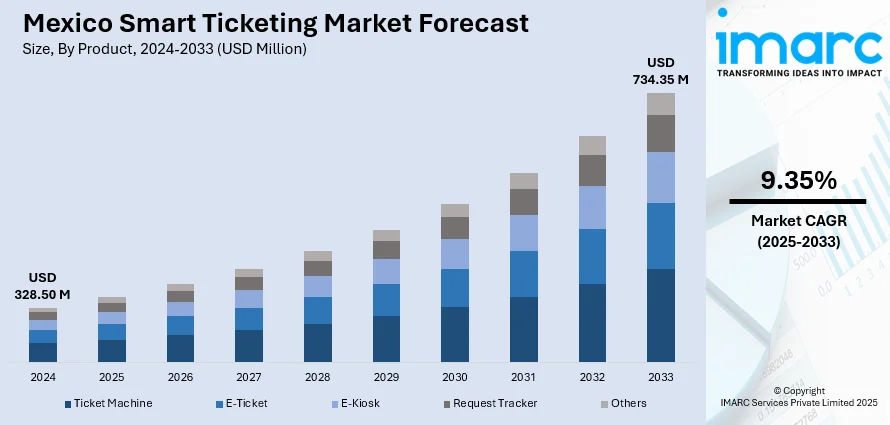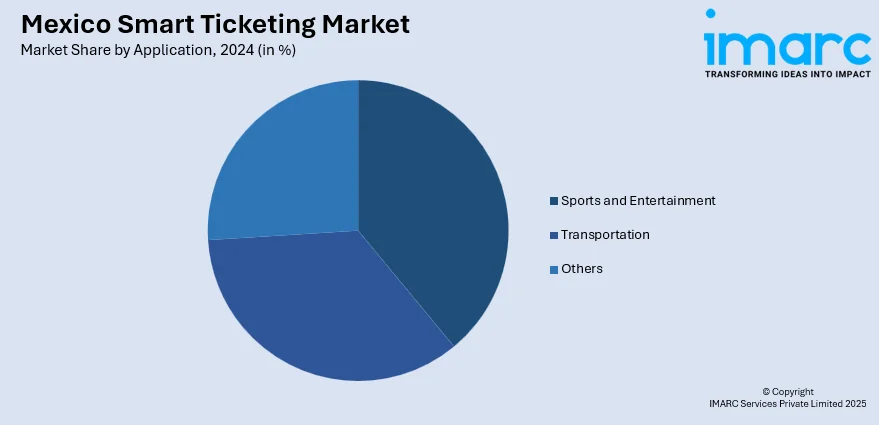
Mexico Smart Ticketing Market Size, Share, Trends and Forecast by Product, Component, System, Application, and Region, 2025-2033
Mexico Smart Ticketing Market Overview:
The Mexico smart ticketing market size reached USD 328.50 Million in 2024. Looking forward, IMARC Group expects the market to reach USD 734.35 Million by 2033, exhibiting a growth rate (CAGR) of 9.35% during 2025-2033. The market is witnessing significant growth due to increasing demand for contactless payment solutions in transportation and entertainment sectors. Additionally, government initiatives promoting digitalization, along with advancements in infrastructure, are driving market growth. Moreover, the adoption of seamless, cashless ticketing systems due to increasing adoption of smartphones is enhancing consumer experience is contributing to the Mexico smart ticketing market share.
|
Report Attribute
|
Key Statistics
|
|---|---|
|
Base Year
|
2024
|
|
Forecast Years
|
2025-2033
|
|
Historical Years
|
2019-2024
|
| Market Size in 2024 | USD 328.50 Million |
| Market Forecast in 2033 | USD 734.35 Million |
| Market Growth Rate 2025-2033 | 9.35% |
Mexico Smart Ticketing Market Trends:
Contactless and Mobile Ticketing Expansion
Mexico's smart ticketing market is witnessing rapid growth in contactless and mobile-based solutions, driven by rising smartphone adoption and urban mobility demands. Cities like Mexico City, Guadalajara, and Monterrey are adopting QR code-enabled ticketing apps and NFC-based transit cards, allowing passengers to board buses and metro services without cash or physical tickets. For instance, in August 2023, Ticketmaster Mexico is transitioning to digital tickets, retiring paper options to enhance security and combat fraud. The SafeTix app will allow users to purchase tickets with dynamic barcodes, reducing counterfeit risks. This shift follows significant backlash from a Bad Bunny concert incident, aiming to improve the overall customer experience. These systems improve operational efficiency and passenger flow, while also minimizing physical contact—an important factor accelerated by pandemic-era hygiene concerns. Government support for digital transformation in public services has further encouraged the rollout of mobile ticketing platforms integrated with transport apps. Initiatives such as Tarjeta MI and digital wallet integration with banking apps are streamlining fare payments, making travel more convenient. With a growing preference for cashless transactions, the country is steadily transitioning toward mobile-first public transit infrastructure.

Public Transport Digitization Push
Mexico's urban transit landscape is undergoing a digital overhaul, with a strong focus on modernizing fare collection systems. Major cities are replacing cash-based and magnetic stripe ticketing with digital solutions across metro lines, BRT systems like Metrobús, and city buses. This shift is aimed at reducing fare evasion, cutting down operational inefficiencies, and enhancing commuter convenience. Projects like Mexico City’s Tarjeta MI and Guadalajara’s digital transit upgrades reflect this trend. The emphasis is on scalable, interoperable systems that allow riders to use a single smart card or mobile app across multiple transit modes. Support from both federal and local governments is accelerating this change, often in partnership with global fare technology providers. For instance, in January 2024, Mexico City Metro phased out magnetic tickets after 54 years, introducing Integrated Mobility Cards for improved efficiency. The final magnetic tickets, designed in tribute to the original, are valid through February. The transition, which began in 2023, will be complete by March across all lines with new electronic validators. These upgrades are central to improving transit system reliability, passenger flow, and overall service quality, driving Mexico smart ticketing market growth.
Mexico Smart Ticketing Market Segmentation:
IMARC Group provides an analysis of the key trends in each segment of the market, along with forecasts at the country and regional levels for 2025-2033. Our report has categorized the market based on product, component, system, and application.
Product Insights:
- Ticket Machine
- E-Ticket
- E-Kiosk
- Request Tracker
- Others
The report has provided a detailed breakup and analysis of the market based on the product. This includes ticket machine, e-ticket, e-kiosk, request tracker, and others.
Component Insights:
- Software
- Hardware
A detailed breakup and analysis of the market based on the component have also been provided in the report. This includes software and hardware.
System Insights:
- Open Payment System
- Smart Card
- Near-Field Communication
A detailed breakup and analysis of the market based on the system have also been provided in the report. This includes open payment system, smart card, and near-field communication.
Application Insights:

- Sports and Entertainment
- Transportation
- Others
A detailed breakup and analysis of the market based on the application have also been provided in the report. This includes sports and entertainment, transportation, and others.
Regional Insights:
- Northern Mexico
- Central Mexico
- Southern Mexico
- Others
The report has also provided a comprehensive analysis of all the major regional markets, which include Northern Mexico, Central Mexico, Southern Mexico, and others.
Competitive Landscape:
The market research report has also provided a comprehensive analysis of the competitive landscape. Competitive analysis such as market structure, key player positioning, top winning strategies, competitive dashboard, and company evaluation quadrant has been covered in the report. Also, detailed profiles of all major companies have been provided.
Mexico Smart Ticketing Market Report Coverage:
| Report Features | Details |
|---|---|
| Base Year of the Analysis | 2024 |
| Historical Period | 2019-2024 |
| Forecast Period | 2025-2033 |
| Units | Million USD |
| Scope of the Report |
Exploration of Historical Trends and Market Outlook, Industry Catalysts and Challenges, Segment-Wise Historical and Future Market Assessment:
|
| Products Covered | Ticket Machine, E-Ticket, E-Kiosk, Request Tracker, Others |
| Components Covered | Software, Hardware |
| Systems Covered | Open Payment System, Smart Card, Near-Field Communication |
| Applications Covered | Sports and Entertainment, Transportation, Others |
| Regions Covered | Northern Mexico, Central Mexico, Southern Mexico, Others |
| Customization Scope | 10% Free Customization |
| Post-Sale Analyst Support | 10-12 Weeks |
| Delivery Format | PDF and Excel through Email (We can also provide the editable version of the report in PPT/Word format on special request) |
Key Questions Answered in This Report:
- How has the Mexico smart ticketing market performed so far and how will it perform in the coming years?
- What is the breakup of the Mexico smart ticketing market on the basis of product?
- What is the breakup of the Mexico smart ticketing market on the basis of component?
- What is the breakup of the Mexico smart ticketing market on the basis of system?
- What is the breakup of the Mexico smart ticketing market on the basis of application?
- What is the breakup of the Mexico smart ticketing market on the basis of region?
- What are the various stages in the value chain of the Mexico smart ticketing market?
- What are the key driving factors and challenges in the Mexico smart ticketing?
- What is the structure of the Mexico smart ticketing market and who are the key players?
- What is the degree of competition in the Mexico smart ticketing market?
Key Benefits for Stakeholders:
- IMARC’s industry report offers a comprehensive quantitative analysis of various market segments, historical and current market trends, market forecasts, and dynamics of the Mexico smart ticketing market from 2019-2033.
- The research report provides the latest information on the market drivers, challenges, and opportunities in the Mexico smart ticketing market.
- Porter's five forces analysis assist stakeholders in assessing the impact of new entrants, competitive rivalry, supplier power, buyer power, and the threat of substitution. It helps stakeholders to analyze the level of competition within the Mexico smart ticketing industry and its attractiveness.
- Competitive landscape allows stakeholders to understand their competitive environment and provides an insight into the current positions of key players in the market.
Need more help?
- Speak to our experienced analysts for insights on the current market scenarios.
- Include additional segments and countries to customize the report as per your requirement.
- Gain an unparalleled competitive advantage in your domain by understanding how to utilize the report and positively impacting your operations and revenue.
- For further assistance, please connect with our analysts.
 Request Customization
Request Customization
 Speak to an Analyst
Speak to an Analyst
 Request Brochure
Request Brochure
 Inquire Before Buying
Inquire Before Buying




.webp)




.webp)












